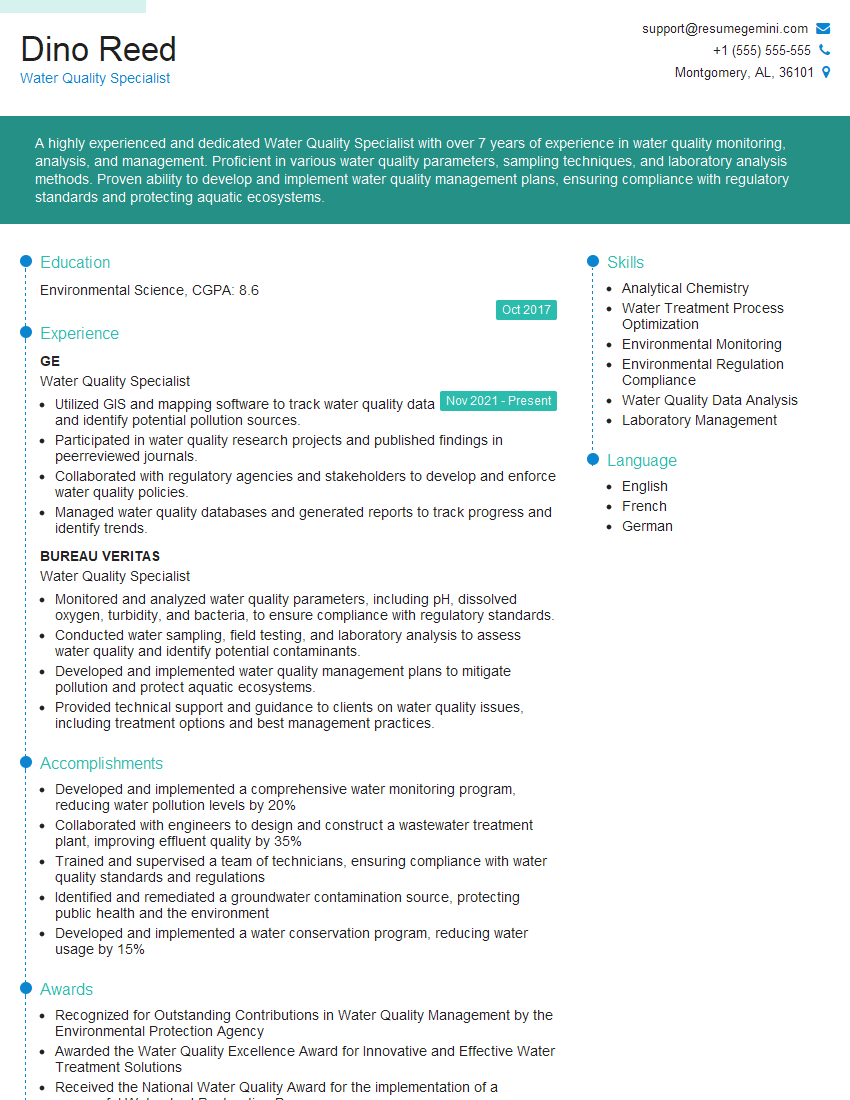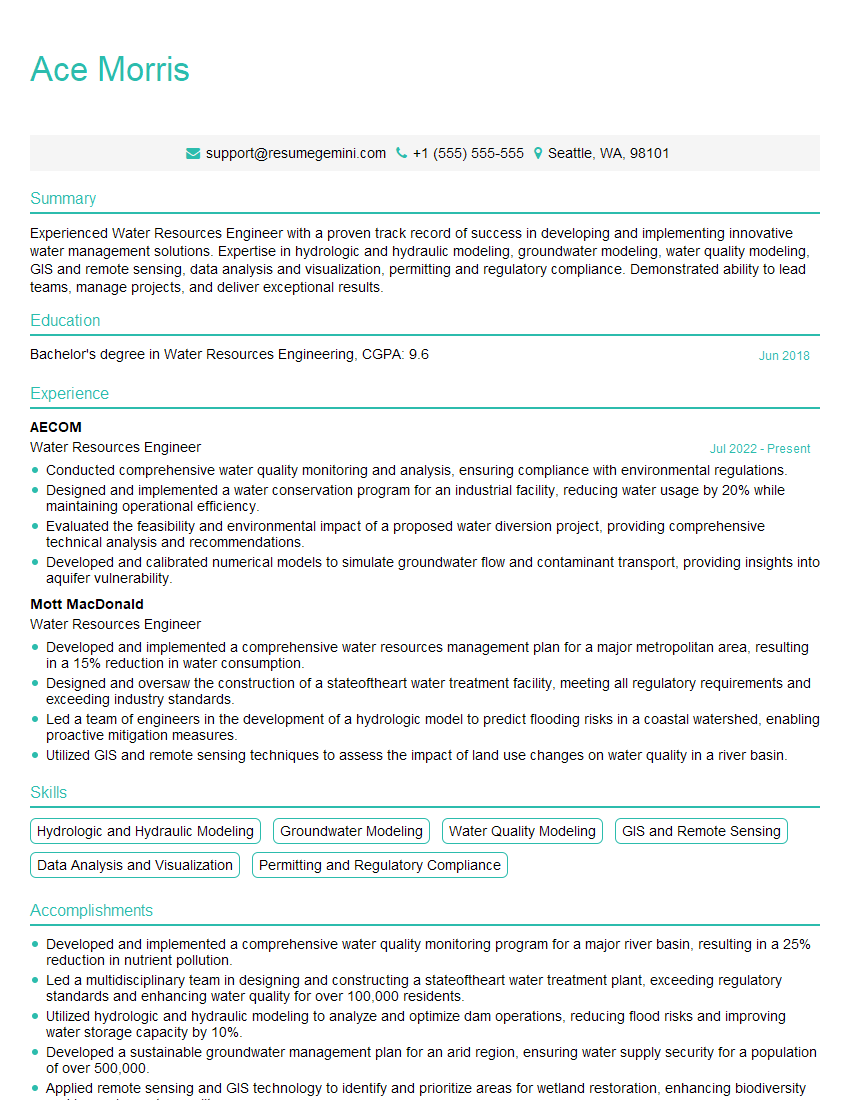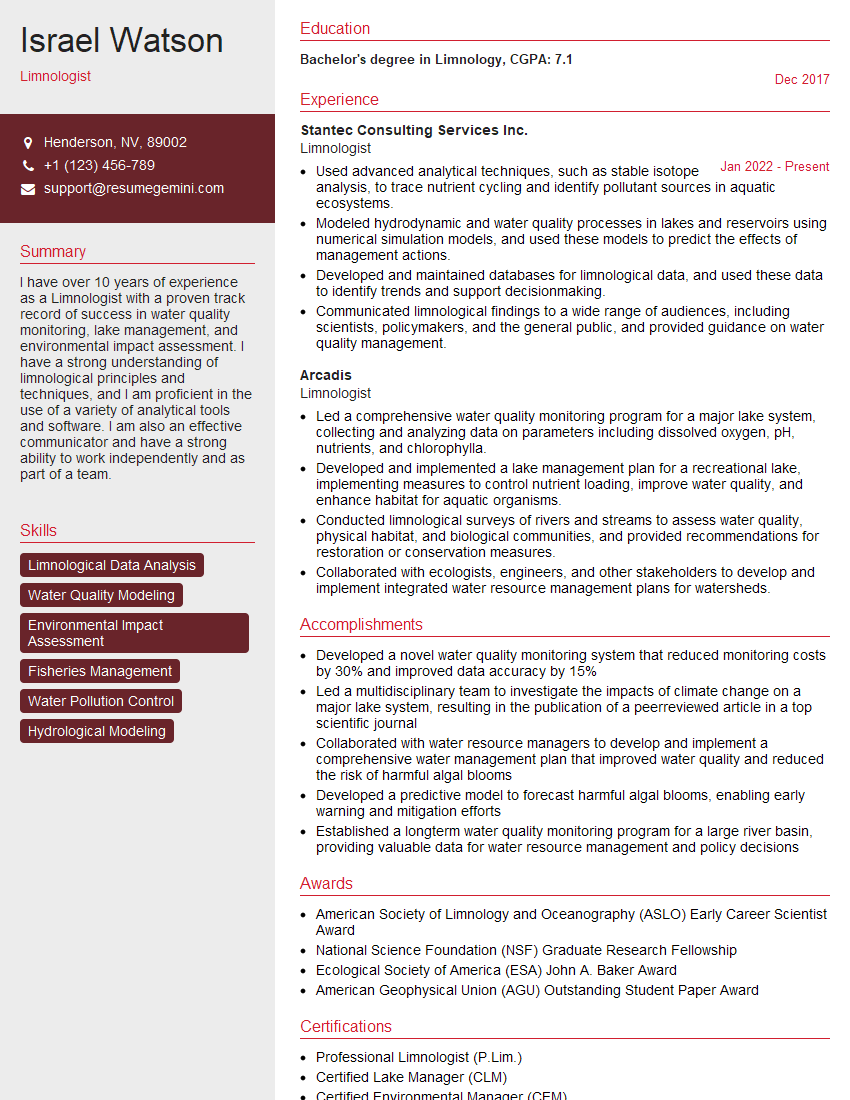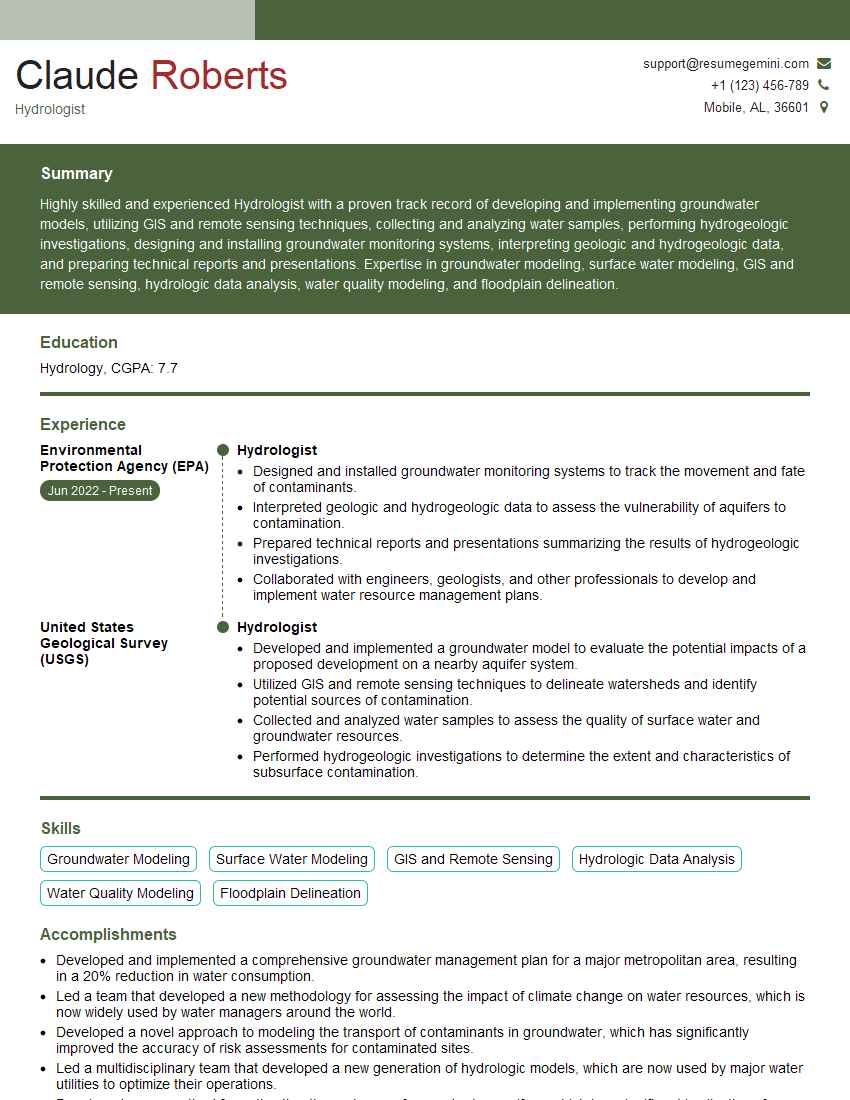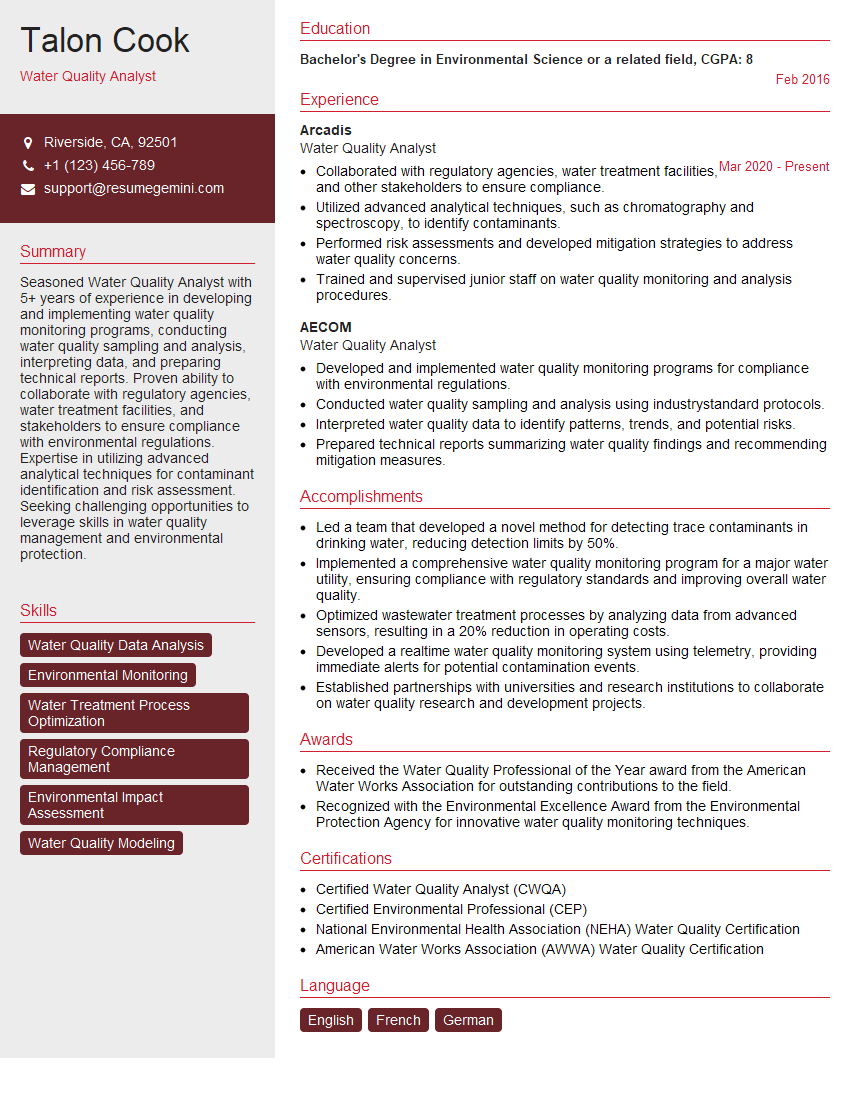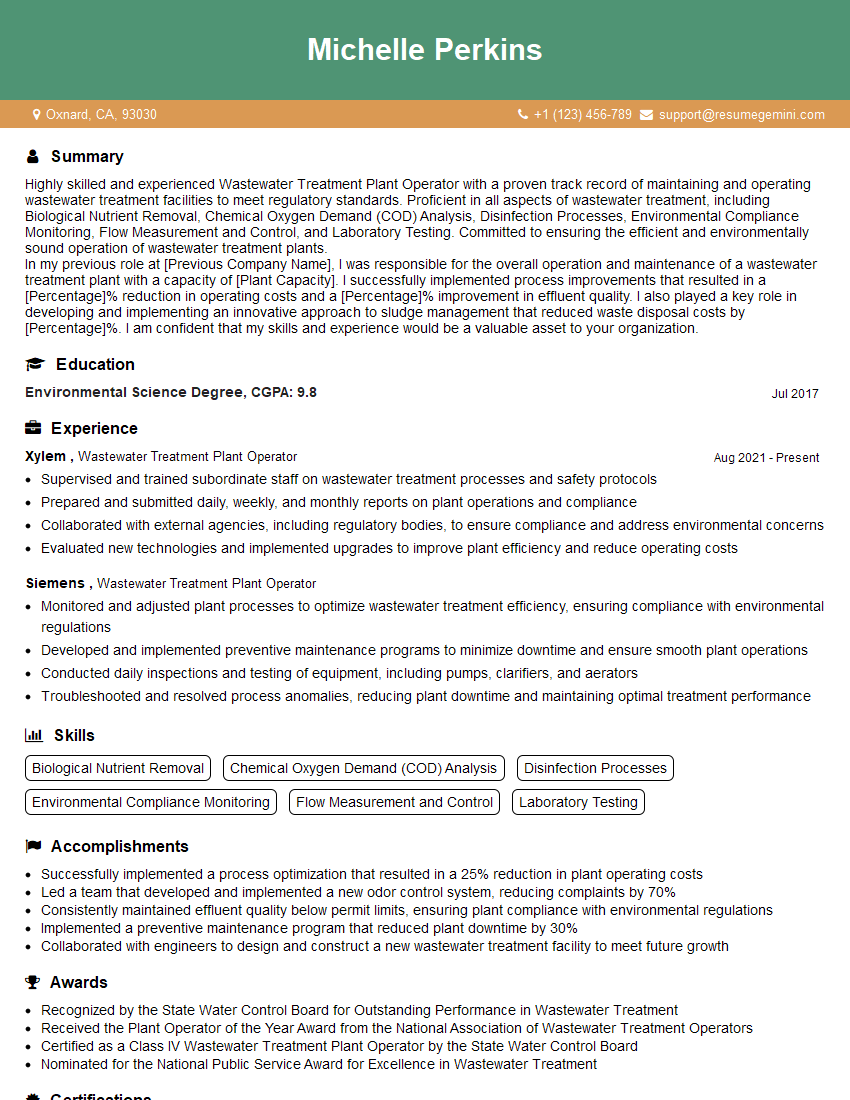Unlock your full potential by mastering the most common Monitoring Water Quality interview questions. This blog offers a deep dive into the critical topics, ensuring you’re not only prepared to answer but to excel. With these insights, you’ll approach your interview with clarity and confidence.
Questions Asked in Monitoring Water Quality Interview
Q 1. Describe the different types of water quality parameters and their significance.
Water quality parameters are the various physical, chemical, and biological characteristics used to assess the overall health of a water body. Understanding these parameters is crucial for determining water suitability for different purposes, from drinking to aquatic life support.
- Physical parameters: These include temperature, turbidity (cloudiness), color, odor, and taste. For example, high turbidity can indicate sediment pollution, affecting aquatic life and water treatment processes. Temperature variations can impact dissolved oxygen levels, crucial for fish survival.
- Chemical parameters: This broad category encompasses pH (acidity/alkalinity), dissolved oxygen (DO), nutrients (nitrogen and phosphorus), heavy metals (lead, mercury, etc.), pesticides, and salinity. High nutrient levels, for instance, can lead to eutrophication—excessive algae growth—which depletes oxygen and harms aquatic ecosystems. Heavy metals are toxic even at low concentrations.
- Biological parameters: These involve assessing the presence and abundance of microorganisms, such as bacteria, algae, and zooplankton. Fecal coliform bacteria, for example, indicate fecal contamination and pose a health risk. The diversity and abundance of other organisms can act as indicators of overall ecosystem health.
The significance of each parameter depends on the intended use of the water. Drinking water requires stringent standards for all parameters, while water used for irrigation might have less stringent requirements for some parameters.
Q 2. Explain the process of collecting and preserving water samples for analysis.
Proper sample collection and preservation are essential for accurate water quality analysis. Contamination can drastically alter results, rendering them useless. The process typically involves these steps:
- Sample Selection: Choose representative sampling locations based on the objectives of the study. Consider factors like flow patterns and potential pollution sources.
- Sample Collection: Use clean, pre-rinsed containers made of appropriate material (e.g., glass for trace metals, polyethylene for most other parameters). Avoid touching the inside of the container. Submerge the container below the water surface to avoid surface contamination.
- Sample Preservation: Immediately after collection, add preservatives as needed to prevent changes in the parameters of interest. For example, adding acid (e.g., sulfuric acid) lowers pH and stabilizes many metals. Refrigeration is often necessary to slow down biological processes.
- Chain of Custody: Maintain a detailed record of sample collection, preservation, and handling to ensure the integrity of the data. This includes labeling samples clearly with date, time, location, and any relevant information.
- Sample Transportation: Transport samples to the laboratory in a cooler with ice packs to maintain temperature and prevent degradation.
For example, when testing for bacteria, immediate refrigeration is crucial to prevent their growth and alter the results. Failing to properly preserve a sample can lead to inaccurate results and misleading conclusions about water quality.
Q 3. What are the common methods used for analyzing water quality parameters like pH, turbidity, and dissolved oxygen?
Several methods are available for analyzing water quality parameters:
- pH: Measured using a pH meter, a device that measures the electrical potential difference between a reference electrode and a pH-sensitive electrode. It’s a simple, rapid, and accurate method.
- Turbidity: Measured using a turbidimeter, which measures the scattering of light by suspended particles. Nephelometric methods are commonly used, measuring the light scattered at 90 degrees to the incident beam.
- Dissolved Oxygen (DO): Measured using a DO meter, which typically uses an electrochemical method (Clark electrode) to determine the amount of oxygen dissolved in the water. Winkler titration, a chemical method, is also used, particularly for historical data comparisons.
In addition to these, other methods are used for other parameters, including spectrophotometry (for nutrient analysis), atomic absorption spectroscopy (for heavy metals), and chromatography (for pesticides).
The choice of method depends on factors like accuracy requirements, available equipment, and the parameter being measured. Each method has its own advantages and limitations and requires proper calibration and quality control to ensure accurate results.
Q 4. How do you interpret water quality data and identify potential pollution sources?
Interpreting water quality data involves comparing measured values to established standards and identifying trends. This process helps determine the overall health of the water body and pinpoint potential pollution sources.
- Data Comparison: Compare measured values against relevant water quality standards (e.g., drinking water standards, aquatic life criteria). Exceedances indicate potential problems.
- Trend Analysis: Look for patterns or trends in the data over time. Increasing concentrations of a pollutant suggest a continuing source of pollution.
- Spatial Analysis: Map the data geographically to identify areas with consistently poor water quality. This can help locate pollution sources.
- Correlation Analysis: Examine the relationships between different parameters. For example, high nutrient levels combined with low dissolved oxygen might indicate eutrophication.
- Source Identification: Based on the above analyses, identify potential pollution sources. This might involve investigating nearby industrial facilities, agricultural runoff, or sewage discharge.
For instance, consistently high levels of fecal coliform bacteria near a sewage treatment plant might indicate a malfunction in the plant’s operation. Similarily, elevated levels of heavy metals downstream of a mining operation suggest contamination from the mine.
Q 5. What are the relevant regulations and standards for water quality monitoring in your region?
Water quality regulations and standards vary by region but generally aim to protect human health and aquatic ecosystems. In many regions, these regulations are based on guidelines from organizations like the Environmental Protection Agency (EPA) in the US or the World Health Organization (WHO). These regulations define acceptable limits for various water quality parameters in different water uses, such as drinking water, recreational water, and aquatic life protection.
For example, the Safe Drinking Water Act in the U.S. sets maximum contaminant levels (MCLs) for various chemicals and microorganisms in drinking water. Similarly, regulations for surface water might set limits for parameters like dissolved oxygen to protect aquatic life. Specific standards and enforcement mechanisms will vary according to the jurisdiction.
Staying updated on these regulations is crucial for anyone involved in water quality monitoring to ensure compliance and protect public health and the environment. Violations can lead to significant penalties.
Q 6. Describe your experience with various water quality monitoring equipment.
My experience encompasses a wide range of water quality monitoring equipment, including:
- Multi-parameter probes: These devices measure multiple parameters simultaneously (e.g., pH, DO, conductivity, temperature) and provide real-time data. This is highly efficient for field monitoring.
- Spectrophotometers: Used for measuring the absorbance or transmission of light through a water sample, allowing determination of various chemical constituents such as nutrients.
- Turbidimeters: As mentioned before, these measure water turbidity, indicating suspended solids levels. Different models offer varying levels of accuracy and precision.
- Automatic samplers: These devices collect water samples at predetermined intervals, crucial for long-term monitoring projects, especially in remote locations.
- Flow cytometers: These sophisticated instruments analyze the size, shape, and fluorescence of individual cells and particles in a water sample, valuable in biological assessments.
I’m proficient in operating, calibrating, and maintaining this equipment, ensuring data accuracy and reliability. My experience extends to both field deployments and laboratory-based analyses, providing a holistic understanding of the process.
Q 7. Explain the concept of water quality indices and their applications.
Water quality indices (WQIs) are numerical scores that combine multiple water quality parameters into a single value, providing a simplified representation of overall water quality. They are useful tools for summarizing complex data and communicating water quality information to the public and decision-makers.
Several WQIs exist, each using different parameters and weighting schemes. For example, the National Sanitation Foundation (NSF) Water Quality Index is widely used in the United States. These indices typically assign weights to parameters based on their relative importance to human health and ecological integrity.
Applications of WQIs include:
- Public Communication: WQIs provide a readily understandable way to communicate water quality information to the public.
- Water Management: They help prioritize areas needing remediation and track improvements over time.
- Policy Development: WQIs inform the development and evaluation of water quality policies and regulations.
- Ecosystem Assessment: WQIs can be used to assess the health of aquatic ecosystems.
While WQIs offer a convenient way to summarize data, it’s important to remember that they are simplifications and shouldn’t be the sole basis for complex water quality assessments. The individual parameters should always be examined in detail for a complete understanding.
Q 8. How do you ensure the accuracy and precision of water quality measurements?
Ensuring accurate and precise water quality measurements is paramount. It involves a multi-faceted approach encompassing proper instrument calibration, meticulous sampling techniques, and rigorous quality control procedures.
Calibration: Before any measurement, instruments like pH meters, conductivity meters, and spectrophotometers must be meticulously calibrated using certified reference materials. This involves comparing the instrument’s reading to known standards and adjusting it accordingly. Think of it like zeroing out a scale before weighing groceries – you need a baseline for accurate readings. We typically use a multi-point calibration, using several standards across the expected measurement range for greater accuracy.
Sampling: The sampling method itself can greatly influence results. For example, grabbing a water sample near the surface will yield different results than a sample from the bottom of a lake, as temperature, oxygen levels, and pollutant concentrations often vary with depth. We use standardized sampling protocols, ensuring representative samples are collected and minimizing contamination. Proper sample preservation (e.g., refrigeration, addition of preservatives) is crucial to prevent changes in the analyte’s concentration before analysis.
Quality Control: We employ quality control checks at every stage. This includes using duplicate samples to assess the precision of our measurements, and analyzing blank samples (containing only the preservative) to detect contamination. We also participate in interlaboratory comparison studies to ensure our data is consistent with other labs, enhancing the overall confidence in our results.
Q 9. What are the potential sources of error in water quality monitoring and how can they be minimized?
Several sources of error can creep into water quality monitoring. These can be broadly classified as sampling errors, analytical errors, and data handling errors.
- Sampling Errors: Incorrect sampling locations, improper sample preservation, contamination during collection, and insufficient sample volume all contribute to inaccuracies.
- Analytical Errors: Instrument malfunction, reagent contamination, operator error during analysis, and the matrix effect (interference from other substances in the water sample) can all lead to unreliable results.
- Data Handling Errors: Transcription errors, incorrect data entry, faulty calculations, and problems with data storage and retrieval are common sources of error.
Minimizing Errors: To mitigate these errors, we employ a robust quality assurance/quality control (QA/QC) program. This includes rigorous training of personnel, regular instrument calibration and maintenance, use of certified reference materials, employing proper sampling procedures, and implementing stringent data management protocols using validated software and double-checking data entry.
Q 10. Describe your experience with data management and analysis techniques for water quality data.
My experience with water quality data management and analysis is extensive. I’m proficient in using various software packages like R, Python (with libraries like Pandas and Scikit-learn), and specialized water quality databases.
Data Management: I utilize relational databases to store and manage large water quality datasets, ensuring data integrity and accessibility. This includes developing clear data structures, implementing data validation rules, and maintaining comprehensive metadata (information about the data itself, like location, date, and methods used). I also have experience with cloud-based data storage and sharing solutions for collaborative projects.
Data Analysis: I use statistical methods to analyze water quality data, identifying trends, patterns, and outliers. This involves descriptive statistics (mean, median, standard deviation), exploratory data analysis (visualization techniques), and inferential statistics (hypothesis testing, regression analysis). For example, I’ve used time-series analysis to identify seasonal variations in pollutant concentrations or regression models to predict future water quality based on historical data. Machine learning techniques, such as clustering and classification, are sometimes employed to identify patterns in complex datasets.
Q 11. How do you identify and troubleshoot problems with water quality monitoring equipment?
Troubleshooting water quality monitoring equipment involves a systematic approach. It starts with careful observation and documentation of the problem.
- Identify the Issue: What is the specific malfunction? Is the instrument not powering on? Are readings inconsistent? Are there error messages? Document all observations with timestamps.
- Check the Obvious: Ensure power supply, connections, and sensor integrity (e.g., clean probes, check for cracks). Sometimes the simplest issues are overlooked.
- Consult the Manual: Manufacturer manuals provide valuable troubleshooting guides and diagnostic codes. Understanding the instrument’s specifications is crucial.
- Calibration and Verification: Recalibrate the instrument using certified standards. This often resolves many issues. If problems persist, compare readings with a known working instrument.
- Preventive Maintenance: Regular maintenance, as outlined in the manufacturer’s recommendations, prevents many problems before they arise.
- Seek Expert Help: If all else fails, contact the manufacturer or a qualified service technician. Some repairs necessitate specialized knowledge and equipment.
Q 12. Explain the principles of water quality modeling and simulation.
Water quality modeling and simulation use mathematical and computational techniques to represent and predict the behavior of water bodies. These models help us understand how pollutants move, disperse, and transform within aquatic systems. They are invaluable tools for management and decision-making.
Principles: The core principles involve developing mathematical equations that describe the physical, chemical, and biological processes affecting water quality. These equations are then solved using numerical methods (often involving computer programs) to simulate the system’s behavior under different scenarios. Commonly used models include:
- Hydrodynamic models: Simulate water flow and transport processes.
- Water quality models: Simulate the fate and transport of pollutants, considering factors like decay, adsorption, and reactions.
- Ecological models: Simulate the interactions between different species and their environment.
Applications: These models are used for various purposes: assessing the impact of pollution sources, predicting the effectiveness of remediation strategies, designing wastewater treatment systems, evaluating the effects of climate change on water resources, and managing water quality in rivers, lakes, and estuaries.
Q 13. What are the different types of water pollution and their impact on aquatic ecosystems?
Water pollution encompasses various contaminants that degrade water quality. The impact on aquatic ecosystems varies depending on the type and concentration of pollutants.
- Nutrient Pollution (Eutrophication): Excess nutrients (nitrogen and phosphorus) from fertilizers and sewage lead to algal blooms, oxygen depletion (hypoxia), and fish kills. Imagine a garden overgrown with weeds – too many nutrients choke out other life.
- Organic Pollution: Untreated sewage, agricultural runoff, and industrial discharge introduce organic matter, depleting oxygen levels and creating unhealthy conditions for aquatic life. This can lead to the proliferation of disease-causing organisms.
- Chemical Pollution: Heavy metals (lead, mercury), pesticides, and industrial chemicals can accumulate in aquatic organisms, causing toxicity and disrupting ecosystems. Bioaccumulation, where toxins concentrate in higher trophic levels, is a serious concern.
- Thermal Pollution: Discharge of heated water from power plants alters water temperature, impacting aquatic species’ survival and reproduction. Think of it like a sudden fever – organisms are not adapted to such rapid changes.
- Sediment Pollution: Erosion from construction sites and agricultural fields increases sediment loads in water bodies, reducing light penetration, smothering benthic organisms, and disrupting habitats.
Impact: These pollutants cause a cascade of negative effects, including loss of biodiversity, decline in fish populations, disruption of food webs, contamination of drinking water sources, and threats to human health.
Q 14. Describe your experience with various water treatment technologies.
My experience encompasses a broad range of water treatment technologies, each suited to different pollutants and contexts.
- Conventional Treatment: This includes coagulation/flocculation, sedimentation, filtration, and disinfection. These methods are widely used for removing suspended solids, organic matter, and pathogens from drinking water and wastewater.
- Advanced Oxidation Processes (AOPs): Technologies like ozone treatment and UV disinfection are effective in removing recalcitrant organic pollutants and disinfecting water. Ozone, for instance, breaks down many harmful chemicals into less toxic substances.
- Membrane Filtration: Microfiltration, ultrafiltration, and reverse osmosis are employed for removing dissolved solids, viruses, and bacteria. Reverse osmosis, for example, forces water through a semi-permeable membrane, leaving behind impurities. This is crucial for desalination and producing ultrapure water.
- Biological Treatment: Activated sludge processes and constructed wetlands utilize microorganisms to break down organic matter in wastewater. This natural process is sustainable and relatively cost-effective.
- Phytoremediation: This involves using plants to remove or reduce pollutants from water. Certain plants can absorb heavy metals from the water, providing a natural and sustainable approach.
The choice of technology depends on the specific pollutants present, the desired level of treatment, and other factors like cost and energy consumption. Often, a combination of techniques is employed for optimal results.
Q 15. How do you communicate complex water quality information to non-technical audiences?
Communicating complex water quality data to non-technical audiences requires translating scientific jargon into easily understandable terms. I use a multi-pronged approach. First, I focus on using clear, concise language, avoiding technical terms whenever possible. If a technical term is unavoidable, I provide a simple explanation. Second, I utilize visuals extensively. Graphs, charts, and even simple diagrams can convey complex trends and patterns much more effectively than lengthy explanations. For example, a bar graph clearly showing exceedances of a specific pollutant is far more impactful than a table of numbers. Third, I leverage storytelling. I frame the data within a narrative that connects with the audience’s concerns and interests. For example, instead of simply stating ‘E. coli levels are elevated’, I might say ‘Elevated E. coli levels pose a risk to public health, potentially leading to illness if people come into contact with the water.’ Finally, I always ensure I tailor my communication to the specific audience; a presentation to local residents will differ greatly from a report to government officials.
For instance, when explaining dissolved oxygen levels to a group of concerned citizens, I would avoid terms like ‘hypoxia’ and instead focus on the impact on aquatic life – explaining how low oxygen levels can kill fish and other organisms, impacting the local ecosystem.
Career Expert Tips:
- Ace those interviews! Prepare effectively by reviewing the Top 50 Most Common Interview Questions on ResumeGemini.
- Navigate your job search with confidence! Explore a wide range of Career Tips on ResumeGemini. Learn about common challenges and recommendations to overcome them.
- Craft the perfect resume! Master the Art of Resume Writing with ResumeGemini’s guide. Showcase your unique qualifications and achievements effectively.
- Don’t miss out on holiday savings! Build your dream resume with ResumeGemini’s ATS optimized templates.
Q 16. What are the ethical considerations related to water quality monitoring?
Ethical considerations in water quality monitoring are paramount. Transparency is crucial; data collection methods, results, and any limitations must be openly reported. Conflicts of interest must be carefully managed; for example, avoiding involvement in projects where personal gain could influence data interpretation. Data integrity is non-negotiable; any manipulation or omission of data is unethical and potentially harmful. Furthermore, responsible data sharing is essential, ensuring data is accessible to relevant stakeholders while protecting sensitive information. Finally, ethical considerations extend to the impact of monitoring itself; minimizing environmental disruption during sample collection and ensuring equitable access to clean water are essential elements.
For example, if a company is funding a water quality monitoring project near their factory, it’s crucial to ensure independent verification of the results to avoid biased data interpretation. Similarly, data should be shared openly with communities potentially impacted by water quality issues, promoting transparency and fostering trust.
Q 17. Describe your experience working with GIS software for water quality mapping and analysis.
I have extensive experience using Geographic Information Systems (GIS) software, primarily ArcGIS, for water quality mapping and analysis. My expertise encompasses data input, spatial analysis, and map creation. I regularly use GIS to visualize water quality data geographically, identifying spatial patterns and trends. This includes creating thematic maps displaying pollutant concentrations, overlaying water quality data with other environmental factors like land use or population density, and performing spatial statistical analyses to identify pollution hotspots or potential sources. For example, I have used GIS to model the spread of a nutrient plume from an agricultural runoff source, allowing for targeted intervention strategies. My skills also extend to the creation of interactive web maps, allowing for public access to water quality information.
For instance, in a project assessing the impact of urbanization on river water quality, I used GIS to overlay land use data with water quality sampling points. This helped identify areas with high levels of impervious surfaces which correlated with increased pollutant concentrations. This spatial analysis directly influenced recommendations for urban planning and stormwater management.
Q 18. How do you prioritize water quality monitoring tasks in a busy work environment?
Prioritizing water quality monitoring tasks in a busy environment requires a structured approach. I typically utilize a risk-based prioritization system, considering factors like the potential health impacts of pollution, the vulnerability of the water body, and the regulatory requirements. I also consider the cost-effectiveness of different monitoring strategies. High-risk areas with vulnerable populations or sensitive ecosystems are prioritized, followed by areas requiring regulatory compliance monitoring. The frequency of monitoring is adjusted based on the identified risk. Regular review and updates are crucial to adapt to changing environmental conditions and emerging issues.
For example, if a community relies on a specific well for drinking water, and recent rainfall has increased the risk of contamination, that site would be prioritized over a less critical location. This ensures resources are focused on the most impactful monitoring efforts.
Q 19. Explain the importance of quality assurance and quality control in water quality monitoring.
Quality assurance (QA) and quality control (QC) are fundamental to reliable water quality monitoring. QA focuses on the overall system, ensuring data are collected, analyzed, and reported accurately and reliably. This includes establishing clear protocols, using calibrated instruments, and training personnel. QC involves specific checks at every stage of the process, verifying data accuracy and identifying any potential errors. This includes field blanks, duplicates, and spike samples, which help assess method accuracy and precision. Robust QA/QC is essential for ensuring data integrity and the validity of any conclusions drawn from the data. Without a strong QA/QC program, water quality data can be unreliable and potentially lead to incorrect decisions that could harm human health or the environment.
For example, if a water sample is collected, it’s important to make sure the bottle was clean and the sample is stored correctly. Running duplicate samples and analyzing them ensures that results are consistent and not affected by laboratory error.
Q 20. Describe your experience with statistical analysis techniques for water quality data.
I have significant experience with various statistical analysis techniques applied to water quality data. These include descriptive statistics (mean, median, standard deviation) to summarize data, correlation and regression analysis to assess relationships between variables (e.g., pollutant concentration and rainfall), time series analysis to identify trends and patterns over time, and ANOVA (Analysis of Variance) to compare water quality between different locations or time periods. I also utilize multivariate statistical techniques like principal component analysis (PCA) and cluster analysis for identifying underlying patterns in complex datasets with many variables. I’m proficient in using statistical software packages such as R and SPSS for these analyses.
For example, I once used time series analysis to identify a seasonal pattern in nutrient levels in a lake, demonstrating how agricultural runoff was a key driver of these variations. This informed targeted management strategies focused on minimizing nutrient loading during critical periods.
Q 21. What are the different types of water bodies (e.g., rivers, lakes, oceans) and their unique water quality characteristics?
Water bodies are diverse, each with unique characteristics affecting their water quality. Rivers are dynamic systems with constantly flowing water, exhibiting longitudinal variations in water quality. Their characteristics are influenced by factors like upstream land use, discharge, and sediment load. Lakes are relatively stagnant, stratified systems where water quality can vary significantly with depth and season. Their water quality is influenced by nutrient inputs, water residence time, and mixing patterns. Oceans are vast and complex, with water quality influenced by currents, tides, and atmospheric inputs. Coastal areas are particularly vulnerable to pollution from land-based sources. Each type of water body requires a tailored monitoring approach, considering its specific characteristics and potential pollution sources. For example, monitoring dissolved oxygen in a river would focus on longitudinal gradients, whereas in a lake, it would involve depth profiles.
For instance, a river might show high levels of sediment after a heavy rainfall, while a lake might experience stratification leading to low oxygen in deeper layers.
Q 22. Explain the concept of water quality standards and their role in protecting public health.
Water quality standards are legally mandated limits on the concentrations of various pollutants in water bodies. These standards are crucial for protecting public health because they safeguard against waterborne diseases and other adverse health effects caused by contaminated water. For example, exceeding the maximum contaminant level (MCL) for lead in drinking water can lead to serious neurological problems, especially in children. These standards are set based on extensive scientific research and risk assessments, considering both acute and chronic health effects from exposure to various contaminants. They consider factors like the intended use of the water (drinking water, recreational water, etc.) and the vulnerability of different populations. The enforcement of these standards involves regular monitoring, testing, and corrective actions by regulatory agencies, ensuring that water sources meet the minimum requirements for human health and environmental protection.
Q 23. How do you assess the risks associated with water pollution?
Assessing risks associated with water pollution involves a multi-step process. First, we identify the pollutants present in the water body, their concentrations, and the potential exposure pathways (e.g., drinking, swimming, consumption of contaminated fish). Second, we utilize established toxicological data and risk assessment models (such as those developed by the EPA) to determine the potential health effects associated with those concentrations. This includes considering factors like the toxicity of the pollutants, the duration and frequency of exposure, and the sensitivity of different populations. For instance, a risk assessment for a chemical spill would involve calculating the potential dose individuals might receive based on proximity and water consumption, comparing this to toxicological benchmarks to assess the likelihood of various health effects. Finally, we weigh these risks against the benefits of water use, considering economic and societal factors. The result of this assessment helps to inform remediation strategies and public health advisories.
Q 24. Describe your experience with developing and implementing water quality monitoring programs.
In my previous role at the state environmental agency, I was instrumental in designing and implementing a comprehensive water quality monitoring program for a major river basin. This involved several key steps: First, we identified key monitoring sites based on factors such as land use, population density, and known pollution sources. Second, we selected appropriate parameters for monitoring based on the potential pollutants and the designated water uses. This included parameters like dissolved oxygen, nutrients (nitrogen and phosphorus), bacteria levels, and heavy metals. Third, we established a rigorous sampling and analysis protocol, ensuring quality control and data management. Finally, we developed a system for reporting and communicating the results to stakeholders, including regulatory agencies, the public, and local communities. We used statistical analysis to track trends over time and to identify areas needing remediation. For example, the data indicated a significant increase in nutrient levels downstream of a certain agricultural area, leading to an intervention focused on reducing fertilizer runoff. The program’s success was evident in the sustained improvement in water quality over several years.
Q 25. What are the emerging trends and challenges in water quality monitoring?
The field of water quality monitoring faces several emerging trends and challenges. One key trend is the increased use of advanced technologies such as sensors, drones, and artificial intelligence (AI) for automated and continuous monitoring. This offers greater efficiency and the potential to identify pollution events in real-time. However, challenges remain in the high cost of some technologies and the need for skilled personnel to operate and interpret the data. Another challenge is the growing complexity of pollutants, including emerging contaminants like pharmaceuticals and microplastics, requiring the development of new monitoring methods and standards. Furthermore, climate change impacts, such as increased rainfall and more frequent extreme weather events, are altering water quality patterns, necessitating more adaptive and resilient monitoring programs. Finally, ensuring equitable access to clean water and effective monitoring in underserved communities remains a critical challenge that demands more targeted attention and resources.
Q 26. How do you stay up-to-date on the latest advancements in water quality monitoring techniques?
Staying current in this rapidly evolving field requires a multifaceted approach. I actively participate in professional organizations such as the American Water Works Association (AWWA) and attend conferences and workshops to learn about new technologies and methodologies. I regularly review scientific literature through journals like ‘Environmental Science & Technology’ and ‘Water Research’. Moreover, I maintain a network of colleagues and experts in the field through collaborative projects and professional associations, facilitating knowledge exchange and staying informed about the latest advancements. Online resources such as EPA websites and government databases also provide valuable information on regulations, standards, and research findings. Continuous learning is crucial in this field to ensure our practices remain effective and cutting-edge.
Q 27. Explain your experience with the use of remote sensing technologies for water quality monitoring.
I have extensive experience utilizing remote sensing technologies for large-scale water quality assessments. In a past project, we used satellite imagery to monitor algal blooms in a large lake. Specifically, we utilized multispectral sensors to detect chlorophyll-a concentrations, a key indicator of algal biomass. This allowed us to map the spatial extent and severity of the blooms over time, revealing patterns not visible through traditional ground-based monitoring. Furthermore, we employed hyperspectral imaging to identify the types of algae present, providing valuable insights into the causes and potential impacts of the blooms. Remote sensing offers significant advantages in terms of cost-effectiveness and spatial coverage, particularly for monitoring large or remote water bodies. However, it’s crucial to acknowledge limitations such as cloud cover and atmospheric interference, which can affect data quality. Data from remote sensing is often best integrated with ground-truthing data from in-situ monitoring to obtain the most accurate and comprehensive water quality assessment.
Q 28. Describe your experience in collaborating with other professionals in water quality projects.
Collaboration is integral to successful water quality projects. Throughout my career, I’ve worked closely with hydrologists, chemists, biologists, engineers, and community stakeholders. For example, in a recent project aimed at reducing nutrient pollution in an estuary, I collaborated with a team of hydrologists to model water flow patterns, chemists to analyze nutrient levels, biologists to assess the impact on aquatic life, and engineers to design and implement remediation strategies. Effective communication and a shared understanding of project goals are paramount for successful collaborations. We used regular meetings, shared data platforms, and joint reports to facilitate seamless teamwork. The inclusion of community stakeholders ensures that project outcomes are relevant to local needs and priorities. This collaborative approach fosters better understanding, enhances project effectiveness, and promotes a sense of ownership among all involved parties, leading to sustainable improvements in water quality.
Key Topics to Learn for Monitoring Water Quality Interview
- Water Quality Parameters: Understanding key indicators like pH, turbidity, dissolved oxygen, temperature, nutrient levels (nitrates, phosphates), and the presence of contaminants (heavy metals, bacteria, pesticides).
- Sampling Techniques: Mastering various sampling methods (grab samples, composite samples, continuous monitoring), proper sample preservation and handling, and chain-of-custody procedures.
- Analytical Methods: Familiarity with laboratory techniques used for water quality analysis, including spectrophotometry, chromatography, and titrations. Understanding the principles behind these methods and their limitations.
- Data Analysis and Interpretation: Proficiency in interpreting water quality data, identifying trends, and drawing meaningful conclusions. Experience with statistical analysis and data visualization tools is beneficial.
- Regulatory Compliance: Knowledge of relevant water quality regulations, permits, and reporting requirements (e.g., Clean Water Act, Safe Drinking Water Act). Understanding the legal framework governing water quality monitoring.
- Water Treatment Technologies: Familiarity with different water treatment processes (coagulation, flocculation, filtration, disinfection) and their impact on water quality. Understanding the principles behind these technologies.
- Problem-Solving and Troubleshooting: Ability to identify and diagnose problems in water quality monitoring programs, develop solutions, and implement corrective actions. Experience with troubleshooting equipment malfunctions.
- Instrumentation and Equipment: Practical knowledge of common water quality monitoring equipment, including probes, sensors, and automated sampling systems. Understanding their calibration and maintenance.
- GIS and Spatial Analysis: Experience using Geographic Information Systems (GIS) for mapping water quality data, identifying pollution sources, and visualizing spatial patterns.
- Reporting and Communication: Ability to clearly and concisely communicate complex water quality information to technical and non-technical audiences through written reports, presentations, and data visualizations.
Next Steps
Mastering Monitoring Water Quality opens doors to a rewarding career with significant impact on public health and environmental protection. To maximize your job prospects, invest time in creating an ATS-friendly resume that showcases your skills and experience effectively. ResumeGemini is a trusted resource that can help you build a professional and compelling resume tailored to the specific requirements of Monitoring Water Quality roles. Examples of resumes tailored to this field are available to guide your efforts.
Explore more articles
Users Rating of Our Blogs
Share Your Experience
We value your feedback! Please rate our content and share your thoughts (optional).
What Readers Say About Our Blog
Interesting Article, I liked the depth of knowledge you’ve shared.
Helpful, thanks for sharing.
Hi, I represent a social media marketing agency and liked your blog
Hi, I represent an SEO company that specialises in getting you AI citations and higher rankings on Google. I’d like to offer you a 100% free SEO audit for your website. Would you be interested?
